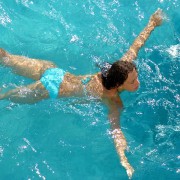 Photo: Getty Images
Photo: Getty Images
Nearly everyone suffers low back pain at some point in their lives, and usually it resolves within a few days or weeks with or without treatment. There are many causes of low back pain, and one of the most common is degenerative disc disease (DDD).
DDD is not really what most people think of as a disease. It becomes more common as we age and can be related to osteoarthritis. By the age of 30 there is no longer a direct vascular supply to the discs, so they begin to dry out bit by bit. As they dehydrate, they provide less cushion to the vertebrae. This can contribute to the growth of bone spurs. DDD can affect any part of the spine, but low back pain is the most common symptom.
Although degenerative disc disease is very common, not everyone feels symptoms. For those who do have symptoms, they are often pain and stiffness and can be improved with exercise or physical therapy. When the pain is acute, a couple of days of rest may be appropriate.
There are things you can do to decrease the symptoms of DDD. A big thing is to stop smoking. Smoking decreases blood flow to the spine and has a big effect on back problems. Exercises to keep your core muscles strong are important. Your core or trunk muscles help hold your spine in place, so a strong core means a more stable, strong back.
Low impact exercises help keep your back strong and flexible. These may include biking, swimming, and walking on flat surfaces. It is also important to use good body mechanics, such as lifting with your knees and using good posture and ergonomics.
If exercise and physical therapy are not enough to control DDD symptoms, it may be appropriate to try other treatments. Acupuncture, medications, and chiropractic adjustments bring relief to some people. Failing conservative measures may mean surgery, but this is not required in the majority of cases.
Dr. Thomas G. Lowe wrote on the Spine Universe site, “It is interesting to note that although 80% of adults will experience back pain, only 1-2% will need lumbar spine surgery!” Usually surgery is only suggested after months of medical management. The exception to this rule is if the low back pain is accompanied by progressive neurological symptoms that indicate pressure on a spinal nerve or impingement of the spinal cord itself.
Sources:
Bader MK, Littlejohns LR: American Association of Neuroscience Nurses Core Curriculum for Neuroscience Nursing, 4th Ed, St. Louis, 2004, Saunders.
Spine-Health: What Is Degenerative Disc Disesase?
http://www.spine-health.com/conditions/degenerative-disc-disease/what-degenerative-disc-disease
Spine Universe: Degenerative Disc Disease and Low Back Pain
http://www.spineuniverse.com/conditions/degenerative-disc/degenerative-disc-disease-low-back-pain



Add a Comment1 Comments
You said,
"The exception to this rule is if the low back pain is accompanied by progressive neurological symptoms that indicate pressure on a spinal nerve or impingement of the spinal cord itself. "
It could be very helpful if you could explain what symptoms would be progressive neurological symptoms. I was told by my neurologist that onset of incontinence after back injury is one symptom they gauge whether or not to do surgery.
August 14, 2011 - 6:15pmThis Comment